
Border Collie Rescue - On Line - Universal Commands - Eat

Universal Commands - Eat
The "Eat" command.
Perhaps this is not an
instruction you would expect to need to teach a dog to do. Stopping
a dog from eating sounds more useful.
It has it's place. Having your dog under control at all times is
beneficial and if you train your dog to eat on command it is less
likely to eat something without being told to. It is more difficult
to get a dog to stop once it has started to eat something.
This
command can help stop the dog from starting to eat something it
comes across because it has not been told it should do so.
In Border Collie Rescue all verbal commands used are accompanied by hand signals which serve
to emphasise and compliment the instruction.
This is of great benefit when training deaf dogs, dogs with learning difficulties and dogs with short attentions spans.
Back to - Universal Commands menu page
This is of great benefit when training deaf dogs, dogs with learning difficulties and dogs with short attentions spans.
Back to - Universal Commands menu page
| Following the command illustrations is some information about feeding routines. |
| The Basic Routine |
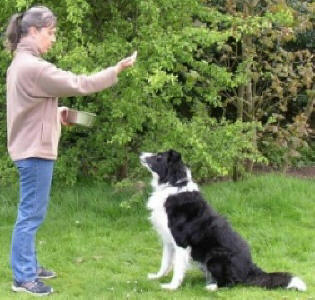 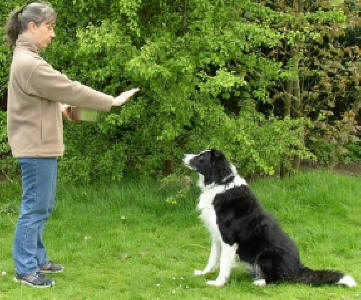 |
| Put you dog
in a Sit or Down position and give Stay
command. |
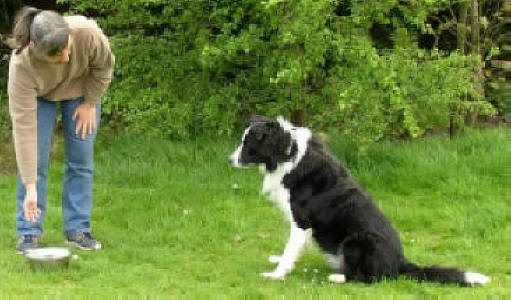 |
| Put food
bowl on the ground in front of him, maintaining the Stay command and sign
if necessary. You may wish to eat a biscuit or something Yourself now to enhance the fact that you are 'Top Dog' and eat before dogs lower in rank. |
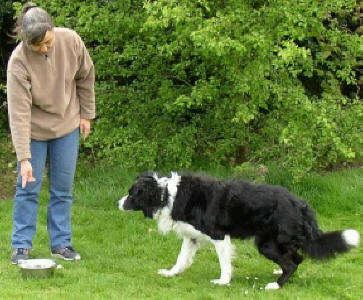 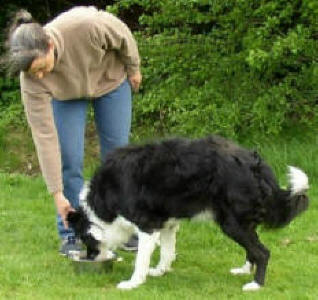 |
| When he has
waited obediently, give the Eat command and point at his bowl. |
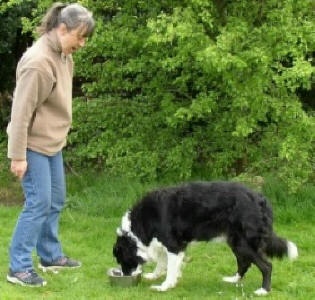 |
| Step back a
short distance so the dog does not feel intimidated. The difficult bit is making sure you can now command him to stop eating, leave his food and move back. |
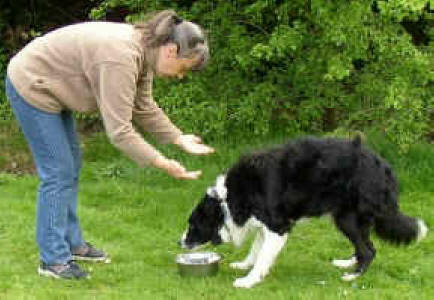 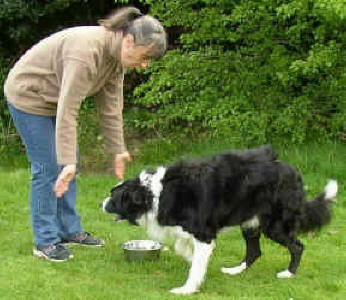 |
| Now, use
verbal command of Leave in conjunction with sign, waving both hands, arms
extended, palms towards dog. |
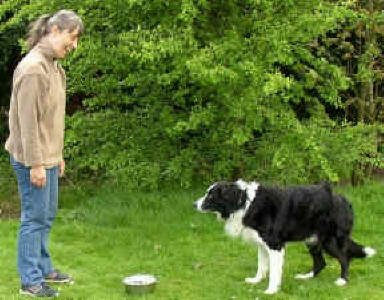 |
| When he is
clear of the bowl, smile and praise. At this point you should step forward and pick up the
bowl. You may need to add further commands to keep the dog from coming forward at this point like Sit, Stay. |
| After a
short period, return the bowl to the ground and give the dog the command to Eat. When you are training this routine repeat it randomly a few times a week.
Always make sure that you give the food back after a short time. |
Dogs with food aggression problems need to be approached in a different way |
| This
routine requires the handler to be within the dogs personal space, in reach of its jaws,
and this may be more than a food aggressive dog can cope with, leading to growling and
attempts to bite. For these dogs and 'older' dogs with ingrained habits, it is important to allow them the space they need by feeding them alone and allowing them to eat in a relaxed environment. It is still important to be able to get a leave command instilled but this needs to be done with more care. |
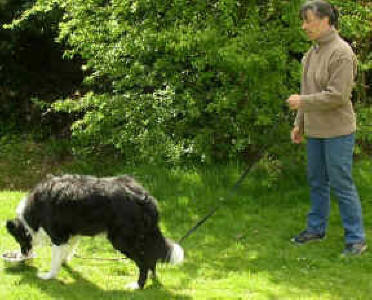 |
| Dogs that
have food aggression problems and may nip or bite if you physically intervene or get too
close, should be taken to their food on a lead. First they should be told to 'Sit' and 'Stay'. The bowl should be placed on the ground a few feet in front of them. It may be necessary to involve a second person in this. They should be held back from the food until the Eat command is given then allowed enough slack to get to the bowl. |
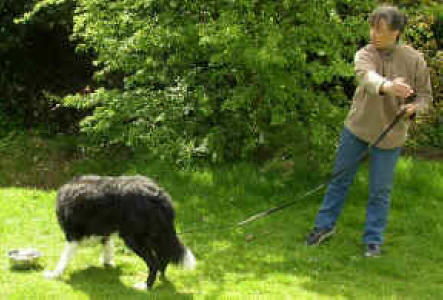 |
| At the
point you decide, you give the 'Leave' command and sign. If there is no response you gently pull the dog away from the bowl by the lead, stepping backwards as you do and repeating the command. |
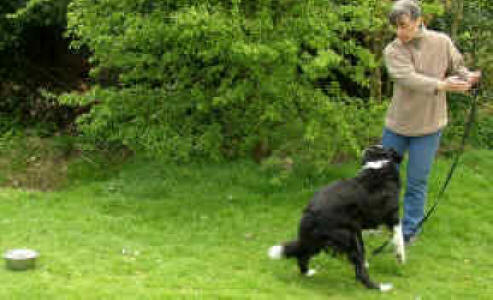 |
| Once the
dog has left the vicinity of the food you can stop moving away and repeat the 'Leave'
command and sign, shortening the lead if necessary, until the dog is level with you. |
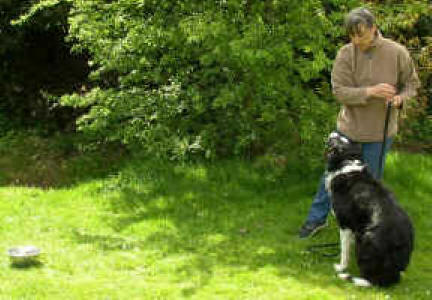 |
| Once the
dog has drawn level with you, use the 'Sit' and 'Stay'
commands to end the routine. At this point the other person may pick up the food bowl briefly before returning it to the ground - but keep a shot lead and a tight grip - just in case. When the bowl is back down and the dog has been praised for its obedience you can give the 'Eat' command again and allow it to finish its meal. |
| This
routine can be practiced until the dog understands the command and will leave the food
without the need to be pulled off by the lead. At this point try it without the lead but
do not attempt to remove the food bowl if the dog comes off. With the loss of restriction
the dog may not be so biddable - if so, let it pass and allow the dog to finish the meal
without confrontation - and return to the routine next meal time. |
Feeding RoutinesDogs Thrive on routines. |
| If
left to their own devices, dogs may be inclined to develop the habit of guarding their
possessions from other dogs and humans. Left unchecked, this may grow into aggression if there are attempts to remove favourite items or interfere. Food can be a particularly sensitive area. It is important to be able to make sure that your dog will stop eating something and back off on instruction. Who knows what he may pick up in the future and what emergencies may be avoided by handlers intervention. Start this routine with your dog as young as possible - bearing the following in mind. |
| Young
puppies and dogs without basic training cannot be expected to respond well to
this routine because the commands used as control, Sit, Stay Etc. will
not be present. With a puppy it is just as important to instil the handler's superiority
in the pack order by controlling the feeding cycle and this can be done with a physical
barrier that prevents the pup/s from getting to the food until the handler is ready. Once the bowl is on the floor, remove the barrier and use the command and sign for Eat. The pup will do the rest quite naturally. As basic training progresses, the pup can be told to Sit and Stay on the outside of the barrier and Eat when the barrier is removed. Eventually there will be no need for the barrier and you can progress to the Leave stage of the training. The same principles can be applied to a dog with poor basic training. The barrier may need to be stronger - perhaps, initially, have a closed door between the dog and the food and use the Eat command and sign when you open the door to let the dog get to his bowl. When the dog has mastered Sit and Stay you can progress with the rest of the routine. |
| Some
dogs are easily intimidated when eating with a person or other dog present. In these cases, it is important to first build up confidence before starting to train this routine. Give these dogs space and freedom to eat, perhaps by feeding them at night when there is no-one around to disturb them. At least give them their food and leave the room to allow them space to gain confidence while eating. As the dogs confidence builds you will find you can be present while they are eating. Initially you can enter the room briefly, ignoring the dog, and leave quickly. As the dog gets used to the interruptions you can extend the time you spend in the room. Once the dog is comfortable with your company at meal times, and has mastered the Sit and Stay commands, you can progress with the rest of the routine. |
| A
dog of this nature may naturally back off when approached while eating. In the pack, if a dominant dog approaches a dog lower in the pecking order, the subservient dog will give ground - or risk the consequences! This does give the handler an advantage as the Leave command and sign can be given to fit the dogs actions and the dog will learn by association to fit the action to the command. But be cautious and allow the dog to build up its confidence first, as above, or you may over dominate and intimidate the dog and create a complex or re-enforce its fear of eating in company. |
| Dogs
with strong food aggression should also be approached in a different way. This routine requires the handler to be within the dogs personal space, in reach of its jaws, and this may be more than a food aggressive dog can cope with, leading to growling and attempts to bite. For these dogs and 'older' dogs with ingrained habits, it is important to allow them the space they need by feeding them alone and allowing them to eat in a relaxed environment. It is still important to be able to get a leave command instilled but this needs to be done with more care. |
| Back to - Universal Commands menu page |
please do not write to us or email us - we want to speak to you before we start the process.
Please phone us during office hours. Details here.
Calls to our office and mobile will only be answered during our office hours


